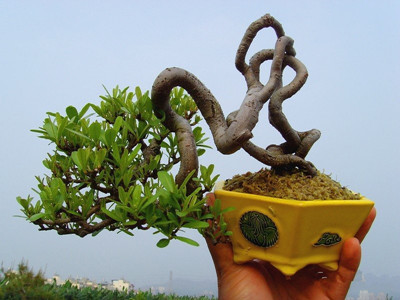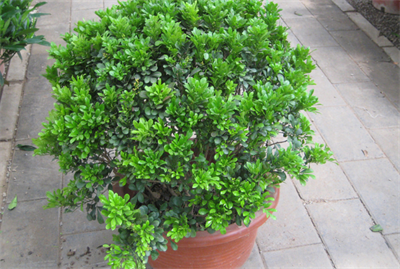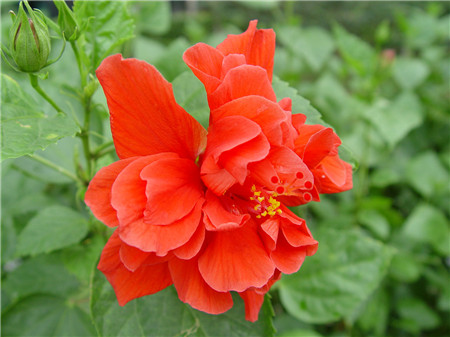Maintenance methods of Pyracantha
Hippophae rhamnoides is a common evergreen bonsai plant of the four seasons, with luxuriant branches and leaves, flowers and leaves, but also fruit, which is favored by the majority of bonsai lovers. The maintenance of Pyracantha has also become an issue of great concern. Next, the editor will show you the maintenance methods of Pyracantha.
The soil of the conservation method of Pyracantha
Hippophae rhamnoides is not strict on the soil, but in order to grow and develop well, we should choose the soil layer is deep; the soil is loose, rich in organic matter, fertile, good drainage, ph5.5~7.3 slightly acidic soil is better.

Watering: the curing method of Pyracantha
Hippophae rhamnoides is resistant to drought, so it is appropriate to keep the soil dry in spring, fertilize once before flowering and fill with enough water. Keeping the soil dry during flowering is beneficial to fruit setting; therefore, it should not be watered too much. If the florescence is in the rainy season, we should also pay attention to digging ditches and drainage to avoid falling flowers due to too much water. After the fruit is ripe and harvested, sufficient overwintering water should be filled before entering winter dormancy.
Third: the sunshine of the conservation method of Pyracantha
Hippophae rhamnoides likes sufficient light and gives sufficient light, which can produce more results and greatly increase the ornamental effect.
Fourth: the temperature of the curing method of Pyracantha.
The optimum growth temperature of Hippophae rhamnoides is 2030 degrees Celsius. In addition, Hippophae rhamnoides also has a strong cold resistance, can still grow normally at-16 degrees Celsius, and survive the winter safely. If planted in a place where the winter temperature is higher than 10 degrees Celsius, the plant dormancy is unfavorable, which will affect the flowering and fruiting of the following year.
Fifth: pruning the maintenance methods of Pyracantha
In the natural state of Hippophae rhamnoides, the crown is disorderly and irregular, and the inner branches are often slender due to lack of light, and the fruit is poor. In order to promote growth and fruit, it is necessary to treat long branches, weak branches and over-dense branches every year. Disease and insect branches are pruned to facilitate ventilation and light transmission and promote shoot growth.
VI: fertilization of conservation methods of Pyracantha
After pruning, firethorn should be applied once cake fertilizer water, at this time in case of wind and rain, should be moved into the room, so as not to affect pollination. Compound fertilizer should be applied once during flowering. After entering the autumn, the second cake fertilizer and water should be applied again in the fruit expansion period.
Seven: the insect pest of the conservation methods of Pyracantha
Pyracantha powdery mildew is one of the main diseases of Hippophae rhamnoides, which infects leaves, twigs, flowers and fruits. During the onset of the disease, the stone sulfur mixture of 0.2-0.3 Baume was sprayed every semimonthly for 2 times. In summer, 0.5 ∶ 1 ∶ or 1 ∶ 1 ∶ 100 Bordeaux solution or 50% acetaminophen 1000 times solution could be used for prevention and treatment.
Culture method of Pyracantha
Pyracantha is usually propagated by sowing, cutting and striping.
Sowing and reproduction
Seed harvesting and storage
The ripening period of Pyracantha fruit is from September to December, and the seedling fruit is suitable to be harvested from January to February. After harvest, remove leaves, branches, stalks and other sundries, spread out in a cool place and ventilate for about 10-15 days, and turn once a day. Hippophae rhamnoides fruit is pear fruit, which contains a lot of pulp. First use a plastic basin or bucket, put an appropriate amount of warm water for 40 ℃, then soak the fruit in a container for 2 hours to make the peel soft, squeeze with hands, squeeze the seeds out of the pulp, then rinse with clean water for 4 to 5 times, remove sundries such as peel, pulp and shrivelled seeds, and obtain black seeds with high purity, ripe and full. The seeds and fine sand should be mixed according to the ratio of 1 ∶ 3. The fine sand should be sifted through a sieve of 200 meshes, and the humidity should be held in the hand. Spread 3cm thick fine sand into the seeds in the lower layer of the indoor corner, cover the upper layer with 5cm thick fine sand for storage, and often check the humidity to prevent frost injury. The seeds of Pyracantha can also be taken out of the pulp and dried.
Sowing seeds
In the first ten days of March of the following year, the seeds and fine sand were scattered evenly on the seedbed prepared before winter, covering the fine soil with a thickness of not seeing the seeds. Because the seeds were small, the soil should not be too thick, and the seedbed was covered with straw and watered. The seedlings began to emerge in about 10 days, when the straw was removed and the moisture was managed according to the humidity of the seedbed. The emergence rate of sowing is 80.6%. The germination rate of Hippophae rhamnoides seeds could be increased by 0.2 ‰ gibberellin treatment. Hippophae rhamnoides is suitable for sowing in the next spring, the seed storage time is too long, the seed germination rate decreases obviously, and Hippophae rhamnoides should not be sown in the environment below 20 ℃. Check the temperature and humidity every day during the seedling period for 3 months. If the temperature is less than 20 ℃ or higher than 30 ℃, heating or cooling measures should be taken, and the main measures are shading, spraying and so on. If there is no abnormal situation, you can water it once a week. Pay attention to waterproofing and drainage in the rainy season.
Cuttage propagation
Spring cutting is generally from late February to early March, selecting healthy and plump branches of one or two years to cut into cuttings of 15cm and 20cm. Summer planting is usually from mid-June to early July. One-year-old semi-lignified cuttings are selected and cut into 12-15 cm cuttings with leafy twigs. The cuttings are treated with ABT rooting powder. Attention should be paid to strengthening water management. The general survival rate can reach more than 90%, and can be transplanted the following spring.
Striping propagation
Can be carried out from spring to summer, select 1-2-year-old branches close to the ground, burn part of the branches to the cambium or peel off half a circle of branches in advance, let organic nutrients accumulate here to facilitate rooting, then carve the branches to the cambium buried in about 10-15 cm, 1-2 years can form a new plant, and then cut off and separated from the mother plant, planted in the following spring.
Cultivation and management
In the process of raising seedlings, fertilizing, watering and weeding should be done in time to reduce the competition between weeds and seedlings for fertilizer and water. After watering, the soil should be loosened in time to increase soil permeability so as to promote fertilizer decomposition and weaken soil water evaporation. There are few diseases and insect pests of Firethorn, and aphids often occur in spring, which can be controlled by spraying 3000 times the enemy; the main diseases are root rot and rust, which can be sprayed with 1% carbendazim, once every semimonthly, and the effect is very good. Rust can be prevented by spraying with 200 × 250 times of rust sodium powder.
Culture method of Pyracantha
Firethorn, also known as red fruit, torch fruit, rescue food and so on. Evergreen shrubs of the rose family. Originated in China, distributed in East China, South China and Southwest China.
There are about 10 species of Pyracantha, which are similar in shape. The main products of origin in China are narrow-leaf firethorn, whole-edge firethorn and fine-toothed firethorn. There are also European firethorns native to Italy and West Asia.
Morphological characteristics the lateral branches of Hippophae rhamnoides are short and the apex is spiny. The leaves are oblong-lanceolate, with round obtuse teeth and a bright surface. Inflorescences compound corymbose, with many flowers, small, white. The fruit is nearly spherical.
The diameter of the fruit bundle is about 5. Bright red, a few orange or yellow.
2-the growth habit likes warmth, and severe frosts often lead to fallen leaves. When there is plenty of sunshine, the flowers and fruits are abundant, and they are slightly tolerant of semi-shade. It can also grow well in dry and barren environment. It is easy to survive if it is often propagated by sowing or cutting. If cutting with fruit in the Meiyu season, it can be cut, potted and grown into miniature bonsai or potted plants.
Horticultural use Firethorn is evergreen all the year round, full of white flowers in late spring, full of red fruits in autumn, does not fall through winter, and is of great ornamental value. it is a common cultivated tree species in the courtyard, which is suitable for isolated planting, or with rocks, which is more interesting. And plant it in front of the wall and weave it into a hedge to give people a sense of ingenuity. Hippophae rhamnoides is also an excellent bonsai tree.
In addition, the fruit of wild pyracantha can also be used to brew red fruit.
Culture method of Pyracantha
- Prev

Reasonable indoor flower cultivation to promote health in summer
On a hot summer day, although the indoor air conditioner can cool down, it closes the doors and windows and blocks the air circulation. Therefore, some flowers with complementary functions can be used as air filters in the room. Most flowers conduct photosynthesis during the day, absorb carbon oxide, release oxygen, breathe at night, and absorb oxygen.
- Next

Cultivation and Management of Mulberry Flower
The mulberry flower grows vigorously, the florescence is long, and needs sufficient nourishment, so ask for potted soil + points to be fertile. The preparation of potted soil for cultivating Fusang should be adjusted according to its growth stage. Attention should be paid to fertilization management during the growing period. Put it in the half shade after serving. After a 15-day slow-growing process, the seedlings were moved to a sunny place.
Related
- Fuxing push coffee new agricultural production and marketing class: lack of small-scale processing plants
- Jujube rice field leisure farm deep ploughing Yilan for five years to create a space for organic food and play
- Nongyu Farm-A trial of organic papaya for brave women with advanced technology
- Four points for attention in the prevention and control of diseases and insect pests of edible fungi
- How to add nutrient solution to Edible Fungi
- Is there any good way to control edible fungus mites?
- Open Inoculation Technology of Edible Fungi
- Is there any clever way to use fertilizer for edible fungus in winter?
- What agents are used to kill the pathogens of edible fungi in the mushroom shed?
- Rapid drying of Edible Fungi

